
Eyes on the Fed and BoJ, Earnings on Fire!
- U.S. Economic Snapshot: Week 30, 2025
- Global Economic Review – Week 30, 2025 (Excluding U.S.)
- U.S. Economic Outlook – Week 31, 2025
- Wall Street & U.S. Dollar Outlook – Week 31, 2025
- Japan Economic Outlook – Week 31, 2025
- Gold Market Review & Outlook – Week 31, 2025
- WTI Crude Oil Market Review & Outlook – Week 31, 2025
- Crypto Market Review & Bitcoin Outlook – Week 31, 2025
Global markets closed the week on a strong note, buoyed by easing trade tensions and strong earnings. Optimism rose after the U.S.–Japan trade deal and signs of progress toward a broader U.S.–EU trade framework. Equities rallied across regions amid growing confidence in global growth. The ECB held rates steady as eurozone inflation returned to its 2% target, citing cooling wage and price pressures. In China, Q2 GDP growth hit 5.2%, slightly above forecasts, though concerns remain over weakening exports and rising deflation risks. Beijing has responded with monetary easing and infrastructure investment. Despite persistent geopolitical and trade uncertainties, global economic resilience was on full display.
U.S. Economic Snapshot: Week 30, 2025
U.S. financial markets rallied in Week 30, 2025, lifted by easing inflation and robust corporate earnings. The S&P 500 and Nasdaq reached new record highs, and the Dow gained 0.5% as investor optimism grew over a potential extended Federal Reserve rate pause. Revised inflation data confirmed the further softening in price pressures, prompting speculation about future rate cuts. The 10-year Treasury yield hovered around 4.38%, dipping slightly as markets anticipated a dovish Fed tone in the upcoming policy meeting.
Earnings season continued to fuel sentiment. The Alphabet posted strong Q2 results with $96.4 billion in revenue and a 32% YoY surge in Google Cloud. In contrast, Tesla was disappointed with a 16% sales drop and eroded margins. Yet, market gains remain narrowly concentrated in a few mega-cap tech stocks, leaving the broader rally vulnerable.
Beneath the surface, economic signals were mixed. Durable goods orders plunged 9.3% in June, with core capital goods and shipments also declining, weakening business investment. The housing market showed deeper cracks: existing home sales fell 2.7%, while the median resale price hit $435,000. Mortgage rates at 6.74% and record-high new home inventory (especially in the South) indicated growing affordability pressures.
Labor data added complexity. Initial jobless claims dropped to 217,000, but continued claims stayed high, hinting at slower rehiring. July’s payrolls report will be closely watched for confirmation of labor market trends.
Meanwhile, political pressure on the Fed intensified as President Trump met with Chair Powell, urging lower rates. The U.S. dollar fluctuated on Fed policy bets, while gold and oil prices slipped due to profit-taking and demand worries.
In summary, Week 30 revealed a U.S. economy navigating between strength and strain. Markets celebrated disinflation and strong earnings, but stress in housing, investment, and employment highlights underlying fragility ahead of key economic data and the Fed’s rate decision.
Global Economic Review – Week 30, 2025 (Excluding U.S.)
In Week 30, global economies outside the U.S. reflected cautious optimism, with major central banks pausing or signaling greater policy flexibility amid improving inflation trends and persistent trade tensions.
Europe
The European Central Bank (ECB) held rates steady, citing inflation’s decline to its 2% target and moderating wage growth. ECB President Christine Lagarde struck a balanced tone, emphasizing resilience in the eurozone economy despite a tepid growth backdrop. Flash PMIs for July suggested output growth picked up to its fastest pace in nearly a year, though manufacturing remained weak. With Q2 GDP expected to show flat growth, the ECB appears comfortable maintaining current policy unless conditions deteriorate further.
In the UK, data remained mixed. July’s composite PMI dropped to 51.0, signaling subdued momentum. Services weakened while manufacturing showed tentative recovery, still in contraction. Inflation rose slightly to 3.6% in June, while retail sales softened, causing the British pound to weaken. The Bank of England, having paused rate hikes in June at 4.25%, is expected to deliver a 25bps cut in August, though further easing will depend on inflation progress.
Asia
China’s Q2 GDP rose 5.2% YoY, surpassing expectations but masking domestic weaknesses. Industrial output was strong, yet retail sales slowed, and deflationary pressures intensified. With consumer prices near 0% and producer prices falling sharply, authorities ramped up stimulus, including infrastructure spending and a May rate cut. The upcoming July Politburo meeting may introduce more support. However, trade risks remain, particularly if U.S.–China tariff tensions resurface after August.
Japan continues to battle with sustained inflation and rising wages. Core CPI eased to 3.3%, still above the BoJ’s target. With wage growth at 5.4%, speculation of policy tightening has grown, but the BoJ held steady in June, keeping its rate at 0.5%. Governor Ueda cited global trade risks as a key reason for caution. The yen fluctuated on expectations of future shifts in monetary policy.
Emerging Markets
Most emerging economies enjoyed stability amid global disinflation. Brazil and India signaled potential easing, while Turkey stood out. The Turkish central bank cut its one-week repo rate by 300bps to 43%, more than expected, amid a decline in annual inflation to 35%. CBRT’s dovish tone suggests additional cuts are possible if inflation continues to fall and geopolitical risks remain subdued.
In summary, global economies are showing resilience and flexibility, with central banks cautiously navigating a complex mix of slowing inflation, external trade pressures, and domestic demand challenges.
U.S. Economic Outlook – Week 31, 2025
As Week 31 (July 28–August 1) unfolds, U.S. markets and policymakers brace for a pivotal stretch of economic developments, headlined by the Federal Reserve’s policy meeting on July 29–30. The Fed is widely expected to hold interest rates steady, emphasizing a data-dependent, “wait-and-see” approach amid gradually cooling inflation and moderate growth. While the central bank retains an easing bias, officials have signaled they need more clarity on how the economy is absorbing past tightening and ongoing trade disruptions before adjusting policy further. Fed Chair Jerome Powell’s post-meeting remarks will be closely scrutinized for guidance on the timing of potential rate cuts later this year.
Key data releases will shape both the Fed’s stance and market sentiment. The advance Q2 GDP estimate, due Wednesday, is expected to show 1.8% annualized growth, primarily driven by a sharp rebound in trade. However, underlying domestic momentum appears soft. Business investment and housing likely contracted, and consumer spending growth remains subdued amid weak wage gains and inflation pressure.
The spotlight will then shift to the July jobs report (due Friday). Payrolls are forecast to increase by around 110,000, down from June’s 147,000. The labor market is cooling as private hiring slows and government hiring retreats. The unemployment rate may rise slightly to 4.2%, while wage growth is projected at just 0.2% month-over-month, reflecting moderate labor cost pressure. The Q2 Employment Cost Index is also expected to show a modest 0.8% quarterly gain.
Additional focus will fall on PCE inflation data and ISM/PMI manufacturing surveys. The PCE is expected to confirm recent disinflation trends, while manufacturing PMIs suggest modest improvement. Stabilizing supplier delivery times and slower tariff fluctuations have helped normalize supply chains, but elevated input costs and weak new orders signal that factory activity remains fragile. Overall, Week 31 will test whether the U.S. economy is edging toward a soft landing—or losing steam.
Wall Street & U.S. Dollar Outlook – Week 31, 2025
In Week 31, financial markets face a delicate balancing act as the Federal Reserve’s policy meeting coincides with the peak of earnings season, creating conditions ripe for volatility. The S&P 500, up nearly 20% year-to-date, remains richly valued with the forward P/E near cycle highs. Traders will closely watch for any shift in the Fed’s tone or surprises in economic data that could jolt sentiment.
If the Fed maintains a dovish posture, emphasizing downside risks and patience, growth stocks may benefit, potentially extending the tech-driven rally. However, any signal that the Fed is wary of market exuberance or sees rate cuts as premature could prompt a pullback in risk assets. The rally’s heavy reliance on a few mega-cap tech stocks (like Apple and Microsoft) makes markets particularly vulnerable to earnings disappointments. Still, strong results could broaden gains across sectors. Technically, the Dow Jones 30 remains bullish as long as it stays above the 50% Fibonacci level (~41,000), with momentum supported by RSI and OBV.
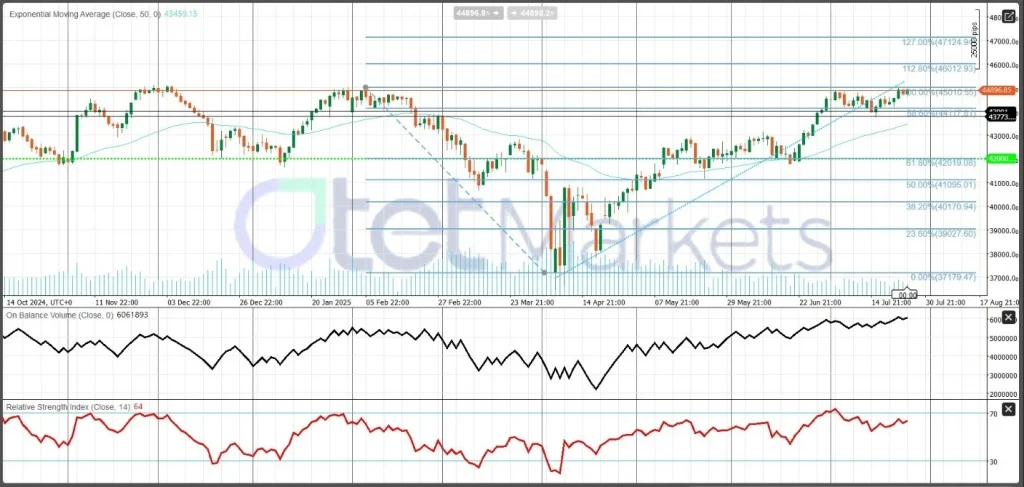
The U.S. dollar (USD) enters the week weaker, having posted its largest weekly decline in a month, as markets price in potential Fed dovishness. The dollar’s direction will hinge on Fed communication, economic data (GDP and jobs), and evolving global trade dynamics. Should Powell reinforce patience and acknowledge inflation progress, it could weaken the dollar further. However, stronger-than-expected data or hawkish surprises could trigger a rebound, as rate differentials shift in the dollar’s favor.
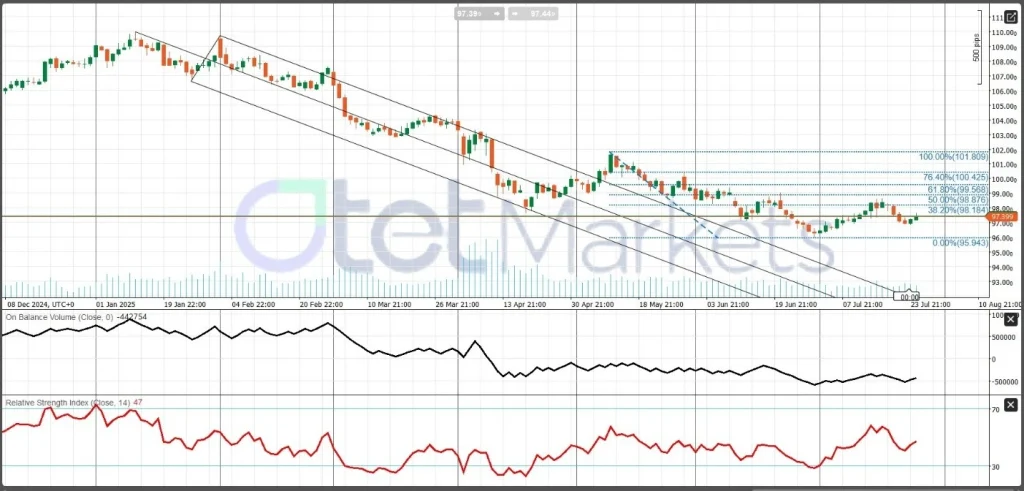
Geopolitical and trade developments also play a role—optimism from U.S.–EU and U.S.–Japan talks has reduced safe-haven demand for dollars. Technically, DXY support stands at 96, while resistance near 99 could cap any rebound. RSI and OBV suggest neutral momentum, with risks skewed toward consolidation unless fresh catalysts emerge.
Japan Economic Outlook – Week 31, 2025
Japan enters Week 31 with intense market focus on the Bank of Japan’s (BoJ) policy meeting scheduled for July 30–31. This meeting comes at a pivotal moment, as Japan experiences sustained inflation and the strongest wage growth in over three decades. Core CPI remains at 3.3%, well above the BoJ’s 2% target, marking four consecutive years above target. Spring wage negotiations also delivered a significant +5.4% pay hike, signaling a potential shift away from Japan’s long-standing deflationary era.
Despite this progress, BoJ Governor Kazuo Ueda has maintained a cautious stance, citing global trade uncertainties and fragile domestic growth. At its June meeting, the BoJ held rates at –0.1% and kept its yield curve control (YCC) framework intact, capping 10-year JGB yields near 0.5%. The bank also slowed bond tapering and reiterated readiness to step up purchases if needed to preserve market stability.
Most analysts expect the BoJ to stay on hold this week but leave the door open to subtle tweaks. Potential shifts include a widening of the YCC band or an upward revision to inflation forecasts, acknowledging that inflation may remain in the 2%–3% range into 2026. Traders will closely watch Ueda’s press conference for clues on the path to normalization.
Japan’s June retail sales and industrial production data will also shape the narrative. Consumer spending has shown modest growth (~1.3% YoY excluding tourism), while industrial output remains volatile due to global demand swings. Upside surprises may increase pressure on the BoJ to adjust policy.
Meanwhile, the yen (JPY) remains under pressure, trading between 144–150 vs. USD, as BoJ dovishness contrasts with other central banks’ prior tightening. A hawkish surprise from the BoJ could trigger sharp yen appreciation and volatility across global bond markets. Conversely, a reaffirmation of current policy could see the yen test multi-year lows.
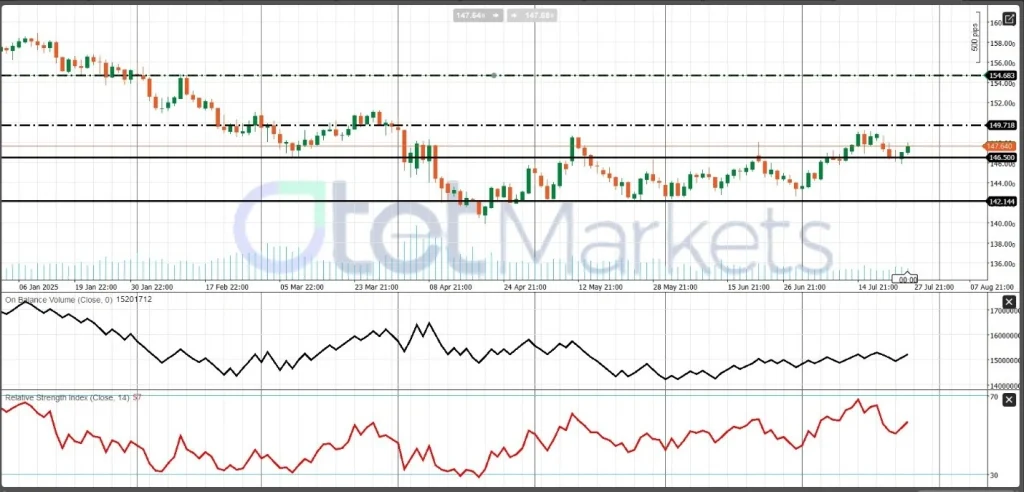
Technically, USD/JPY remains bullish above the pivot at 146.50. A breakout above 149 may extend gains, while a break below opens downside toward 142. In summary, Week 31 is a key test for Japan’s monetary path. Any policy signal shift could mark the start of a long-awaited BoJ normalization—or extend the wait into autumn.
Gold Market Review & Outlook – Week 31, 2025
Gold prices eased in Week 30, consolidating just below record highs as markets balanced shifting sentiment. Spot gold (August futures) dipped 0.97% on Friday to around $3,340/oz, marking its lowest level in two weeks. Still, gold remains up nearly 40% year-to-date, underscoring its strong performance throughout 2025. The recent pullback stemmed from improved risk appetite—tech-driven equity rallies and progress in U.S.–EU trade talks reduced near-term geopolitical fears, prompting a shift from safe havens like gold.
Meanwhile, the U.S. dollar firmed, and 10-year yields hovered near 4.4%, both weighing on gold. Because gold offers no yield, higher real interest rates and a stronger dollar typically reduces its appeal. Yet, the underlying support remains strong. Earlier in the week, gold briefly hit a new all-time high near $3,400, with longer-term investors and central banks continuing to buy dips. Ongoing geopolitical tensions, especially involving Russia, China, and trade policy, sustain gold’s safe-haven demand.
Looking to Week 31, gold’s trajectory hinges on the Federal Reserve’s policy meeting and key U.S. data (GDP and July jobs). A dovish Fed tone, hinting at patience or future rate cuts, could weaken the dollar and lift gold. Conversely, signs of stronger growth and hawkish signals may keep gold in consolidation. The August 1 U.S. tariff deadline adds another layer of uncertainty. Gold may trade sideways until clarity emerges.
Technically, gold shows support around $3,300 and resistance near $3,370. A breakout above resistance could renew bullish momentum; a drop below support might invite further profit-taking. Analysts view $3,000 as a new psychological floor, with long-term forecasts (e.g., JPMorgan’s $3,675 Q4 target) reflecting optimism tied to peaking rates and geopolitical risks.
Overall, gold’s short-term outlook is cautiously bullish, with dips likely to attract buyers amid ongoing global uncertainty.
WTI Crude Oil Market Review & Outlook – Week 31, 2025
WTI crude prices declined in Week 30, closing around $65.16 per barrel, down 3% weekly and hitting a three-week low. Brent crude also dropped to $68.40, reflecting mounting demand concerns and rising global supply. Weak U.S. business investment data and declining Chinese fiscal revenues raised questions about fuel demand from the world’s two largest oil consumers. Additionally, the prospect of eased U.S. sanctions on Venezuela, potentially adding 200,000 barrels/day, and sustained Russian exports further pressured prices.
Supply growth continues through OPEC+’s production hikes, with eight members expected to add 548,000 bpd in August. This coordinated increase—encouraged by the U.S. to stabilize gasoline prices—has helped cap oil rallies. Yet, supply fragilities persist outages in Libya and Nigeria, reduced Russian exports (due to port maintenance), and falling U.S. rig counts (down 12 of the past 13 weeks) may limit further output growth.
The upcoming OPEC+ Joint Ministerial Monitoring Committee (JMMC) meeting on Monday, July 28, is expected to endorse current policy. Still, traders will scrutinize any comments hinting at production restraint post-September, when the bloc is set to fully unwind earlier cuts.
Despite bearish sentiment, crude avoided a steeper selloff due to optimism around U.S.–EU trade talks, and expectations that a dovish Fed could weaken the dollar, indirectly supporting oil. The Fed’s rate decision and U.S. GDP and jobs data will be key market drivers. A strong economic boom could revive demand hopes; weak results might reignite recession fears. Oil traders will also monitor U.S. crude inventories, which unexpectedly rose last week, suggesting adequate supply.
Geopolitical risks remain in play. Iran’s renewed nuclear talks with Europe and ongoing U.S.–EU trade negotiations could affect sentiment and longer-term supply.
Technical analysis suggests WTI has support around $64 and resistance near $68. Many traders see current prices as range-bound in the absence of a major catalyst. The fact that summer demand has not pushed prices higher is telling – it implies ample supply or demand not as strong as expected. However, with hurricane season lurking (which can disrupt Gulf of Mexico output) and global inventories not excessively high, there is also limited appetite to short oil aggressively at these levels.
Outlook: Oil prices are expected to trade in a cautious range during Week 31. Barring surprises, Brent in the upper $60s and WTI in the mid-$60s reflect a balanced market. A break below $60 could spark OPEC action; above $75, pressure from consumer nations would likely rise. Traders are set to closely follow macro data and OPEC+ tone.
Crypto Market Review & Bitcoin Outlook – Week 31, 2025
The crypto market faced turbulence in Week 30, led by a sharp correction in Bitcoin (BTC). After reaching the mid-$120,000s earlier in July, BTC plunged below $116,000, hitting a low near $113,000. This triggered over $155 million in liquidations of leveraged long positions, as BTC broke key technical support. The reversal followed a failed breakout above strong resistance at $119K–$120K, which prompted a cascade of algorithmic selling. Trading volume surged over 25%, reflecting panic selling mixed with some dip-buying interest.
Altcoins mirrored Bitcoin’s decline with even steeper losses. Ethereum (ETH) dropped about 6%, while XRP and Dogecoin fell 17% and 18.5%, respectively. The sell-off reflected broader deleveraging, with institutional and large holders also trimming exposure. Ethereum’s staking exit queue grew past 640,000 ETH, signaling caution. Still, the Fear & Greed Index held at “Greed” (66), suggesting sentiment remains constructive, and many view this as a healthy correction, not a trend reversal.
Looking to Week 31, Bitcoin consolidates between $113K and $120K. The 20-day moving average at ~$114,700 acts as near-term support. A break below could target $109K; above $120K could restore momentum. Technical indicate a critical junction.
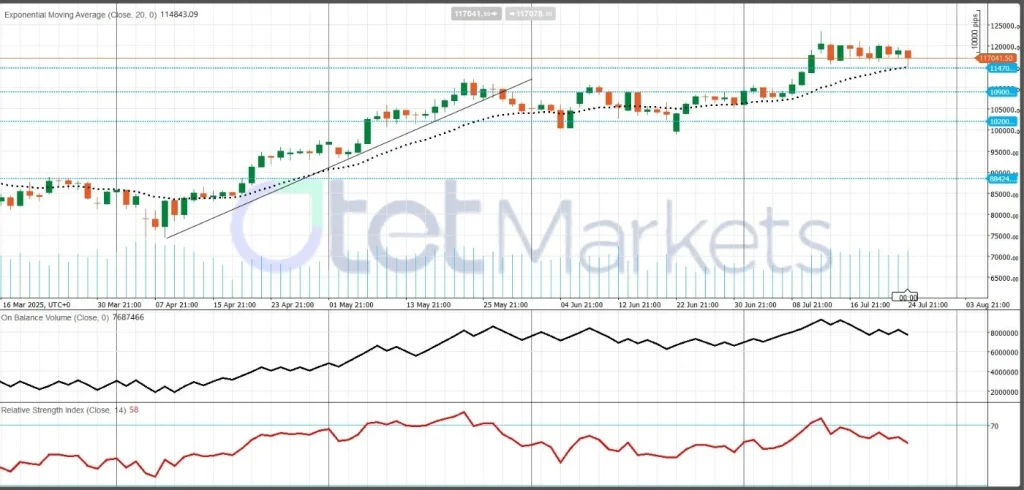
Fundamentals will shape direction. A dovish Fed stance, strong equities, or positive macro data could boost crypto. Conversely, hawkish surprises or equity market weakness could pressure BTC further. Regulatory developments also matter ongoing speculation about Bitcoin and XRP ETFs, plus outcomes in the Ripple vs. SEC case, could drive sentiment.
Crypto enters Week 31 in a cautious but not bearish phase. BTC’s ability to hold key support and macro/crypto news flow will decide whether this is a pause before new highs—or the start of a deeper retreat. Flexibility and vigilance are key for traders in this volatile phase.
Share
Hot topics

Best Forex Trading Hours for Iranian Traders
The Forex market operates 24-hours a day, but clearly not every hour, equal it could even be every trading session, is profitable. There are times when the market sleeps, is...
Read more

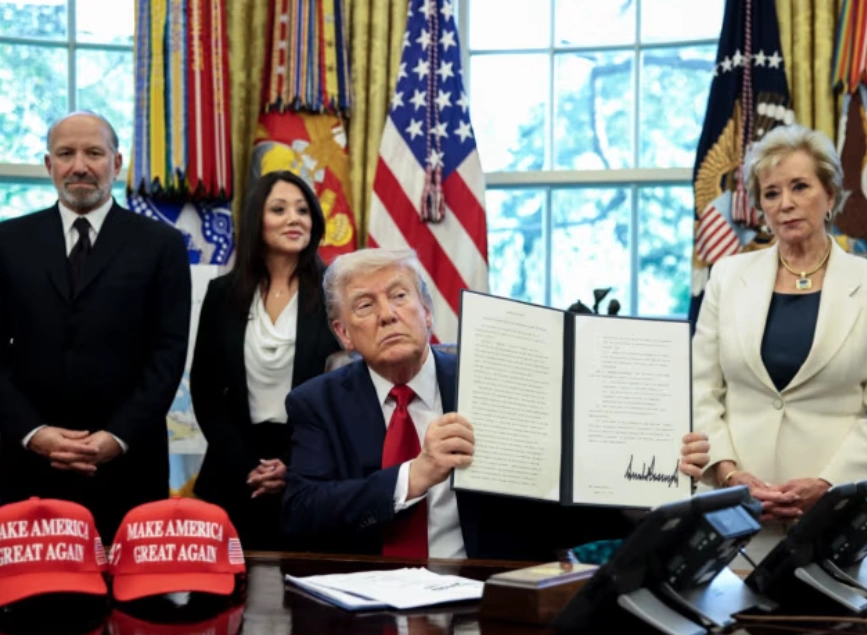


Submit comment
Your email address will not be published. Required fields are marked *